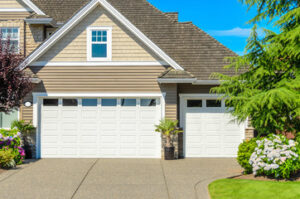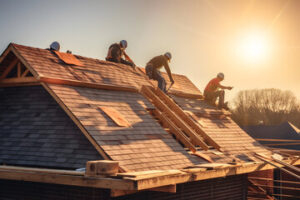A garage door can be a significant inconvenience when it breaks down. However, many problems can be fixed with careful upkeep and regular inspections.

Performing minor repairs is fairly easy, but more serious issues should be left to the experts. A qualified professional has the technical knowledge, problem-solving skills, and ability to read diagnostic manuals to quickly assess and repair the problem. Contact Garage Door Repair Goodyear AZ for professional help.
A broken garage door spring can be a disaster for any homeowner. Because the garage door is so heavy, it relies on the springs to counterbalance gravity’s pull and allow it to move up or down without falling. If a spring breaks, the entire system is compromised, and the garage door will either fall quickly or come crashing down, possibly injuring anyone standing underneath. Even if the garage door still opens, it will be crooked and not function properly.
Typically, the first sign of a problem is when one of the springs begins to wear out. Most residential springs are rated for only about 10,000 cycles, and the average home goes through two or more of these cycles every day, with people entering and exiting the garage multiple times throughout the day. This means that your garage door’s springs are likely to wear out before the manufacturer’s warranty expires.
Garage door springs are under a lot of tension, which makes them dangerous to work with even for experienced do-it-yourselfers. Most professionals recommend hiring a professional to replace your garage door springs and ensure that they are correctly set for your home. This will prevent the door from becoming crooked and help your new springs last longer.
The first step in replacing a garage door spring is to remove the spring from the track bracket and spring pulley. Homeowners should use a piece of tape to mark the current location of the pulley so that it can be reinstalled in the same place once the replacement is complete.
Once the spring is removed, homeowners can disconnect the safety cable from the track bracket and unscrew the spring pulley from the head bearing. Homeowners can then begin to wind the new spring, starting with the end closest to the door opening. When you’re finished, the spring should be evenly tightened to avoid over-winding and creating a potential hazard.
If you’re having trouble with your garage door, a professional can provide a free safety inspection and make sure the mechanical parts of the system are in working order and up to industry standards. Call Precision today to schedule an appointment.
Damaged Panels
The panels that make up the exterior of garage doors aren’t just for aesthetics – they are what support and connect the rest of the system. When one of these sections is damaged, it can have a big impact on how the door operates and looks. If the damage is serious, it’s important to consider repair or replacement options carefully.
The first step is to assess the severity of the panel damage and determine if it’s cosmetic or impacts structural integrity. Minor dents and scratches may be able to be fixed with a dent puller or filler, while cracks or bends should be addressed right away to prevent further damage and extend the lifespan of the garage door. A professional garage door technician can help you choose between repair and replacement based on your specific needs and the extent of the damage.
It’s also important to remember that any kind of impact on the panels can do more than just affect the appearance – it could potentially compromise the safety and functionality of the entire system. If a car has backed into the door or there was a major storm that caused significant damage, it’s worth looking at more extensive repairs than just replacing the panel.
Replacing a single panel is typically the best option if it’s the only one with damage, and if the rest of the door is in good condition. It’s also possible to replace just the section that’s damaged, depending on your preference and the manufacturer of your garage door.
If you’re considering panel replacement, it’s a good idea to ask your local garage door technicians if they offer matching color paints. They can often find exact matches for your existing garage door, allowing you to keep the look of your home consistent and updated. A professional can also check the manufacturer of your door to see if they have spare parts available, which can save you money and time. If you have wood panels, regular termite inspections are also a must to protect against infestations. Using termite repellents can significantly lower the risk of damage to your home’s woodwork and other structures.
Torn Weather Stripping
There are times when it’s pretty clear your car needs new weather stripping—you might see water leaking in or there might be some visible gaps. But there are also instances where the problem isn’t quite so obvious. Weather stripping is designed to keep out rain, wind, cold air and even bugs. It’s a critical part of your car’s protection system, so if you notice gaps or leaking, you should make sure to fix it right away to prevent other problems like mold and mildew.
If you can’t afford to buy a full replacement, try to repair the gaps instead. Start by examining the entire periphery of your vehicle to locate the areas where you can feel or hear the wind or cold air coming through. You’ll often find that the problem isn’t the seal itself but simply that it has become dislodged from its original seating point. If this is the case, use a snap clamp or another device to hold it in place while you apply weatherstrip adhesive. This will reseal the seal to your car’s frame and give you some extra peace of mind until you can replace it again.
You may also have a spot where the weather stripping has been ripped or torn, but is still in good shape overall. You can patch this with some universal weather seal, which can be purchased in rolls. Just cut the length you need and stick it where your existing weather stripping is torn or frayed. The adhesive used to stick it will also help to reinforce the torn area.
If your weather stripping is a little more severe, you might need to replace it entirely. This isn’t an expensive project and will ensure that your car keeps its integrity and is protected from the elements. There are several types of weather stripping you can choose from, but make sure to pick a product that matches your car’s make and year. You can even look up the car model online to get a list of available options.
Before you begin removing the old weather stripping, clean the area with a damp cloth or spray some weather stripping remover on it to soften the adhesive. Then wipe it down and dry it completely. Finally, prepare the frame for new weather stripping by cleaning it of any residual moisture or rubbing it down with fine-grain sandpaper to smooth it. You should also fill in nail holes with paintable wood filler before applying any new weather stripping.
Broken Cables
The cables on a garage door are vital to its operation, but they are also vulnerable. Over time, normal wear and tear combined with the stress of supporting the weight of the door can degrade or strain the cables, leading to them eventually breaking. A broken cable can have a huge impact on your door, and it should be replaced as soon as possible. This can prevent further damage, protect the safety of you and your family, and keep the door functioning correctly.
You may not be able to see a broken cable, but there are many signs that you might notice if one is damaged. You might hear squeaking or strange noises while the door is moving, notice that it lifts unevenly, or that it seems unbalanced. If you notice any of these issues, call a technician to inspect and replace your garage door cable.
There are two types of cables on your garage door: lift and retaining. Lift cables are attached to the bottom of the door and connect to the torsion springs above them, helping counterbalance the weight of the garage door. Retaining cables run along each side of the garage door and hold the springs in place, preventing them from flying out when the door opens or closes. Both types of cable can break due to several factors, including regular use and exposure to the elements, lack of proper maintenance, and poor pulley bearings.
When a cable breaks, it can cause the system to shift to place more strain on the other cable, which could lead to additional damage and cost you more money in repairs. If you notice a broken cable, it is important to avoid using the garage door until a professional can take a look at it. Trying to open or close the door with a snapped cable can result in further injury and damage.
When replacing a cable, make sure to trace the path of the old one and carefully disconnect it from its attachment point on the drum. Take note of the direction that the old cable traveled through the pulley, as you will want to wind the new cable in the same way to reduce friction during operation.
